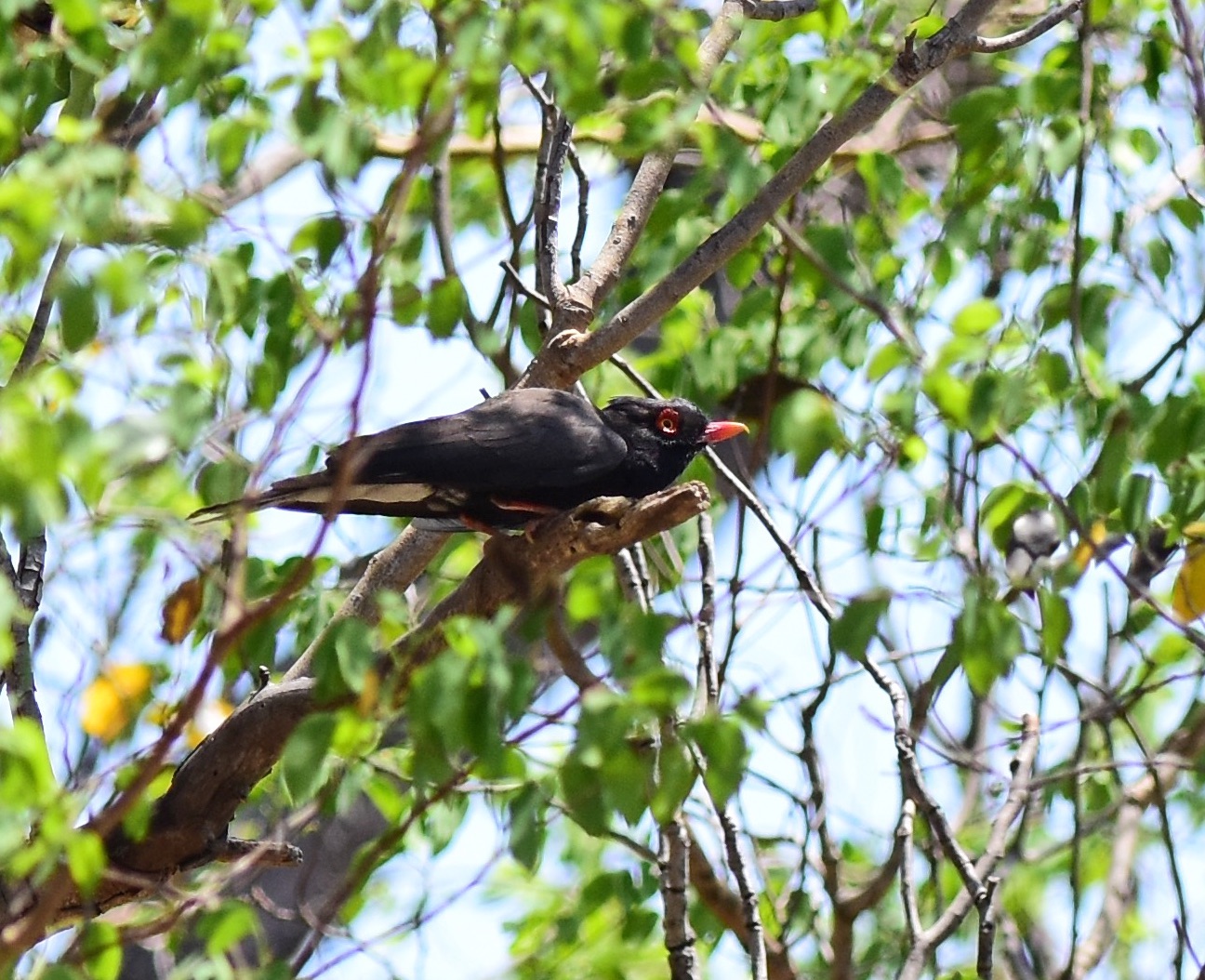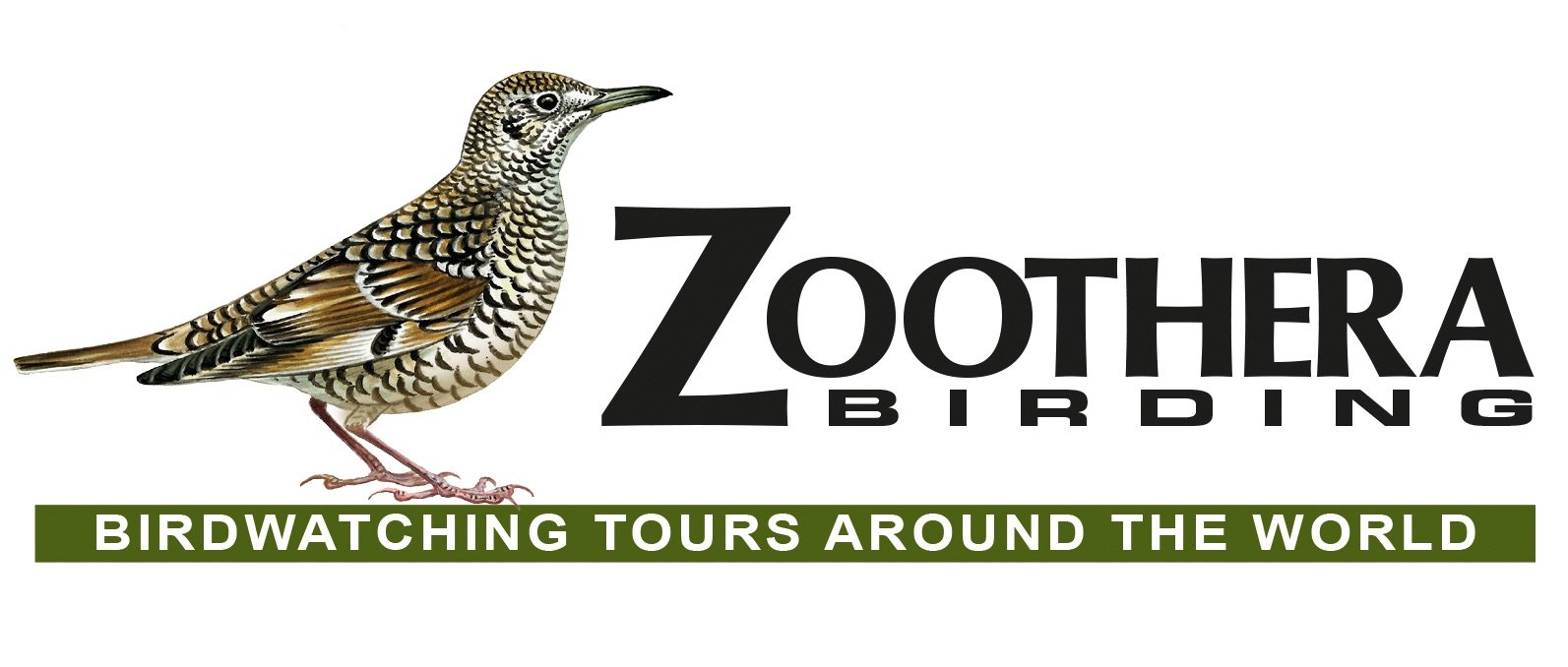ANGOLA BIRDING TOUR ITINERARY In search of Endemics in Unexplored SW Africa
Day 1 ARRIVAL IN LUANDA - 30th July
Arrival and transfer to a hotel in Luanda.
Days 2 - 3 LUANDA - UIGE
A fairly long drive today as we travel north towards Uige. The Guinea Forests reach the northern parts of Angola in this area, the wider area known as Quitexe. En route there are a few birding spots where we should bump into our first targets of the trip.
We spend the full day birding the remnant forest and surrounds. In spite of the disturbance of the forest, most species have hung on and eke out a living in the large trees, left as shade for the crops and coffee plantations. Birds we are on the lookout for include the beautiful endemic Braun’s Bushshrike, Red-crested Turaco, Western Bronze-naped and Afep Pigeons, African Pied Hornbill, Black-backed, Naked-faced and Bristle-nosed Barbets, Buff-spotted Woodpecker, Yellow-throated Nicator, Banded Prinia, Cassin’s Flycatcher, Black-collared Bulbul, Tit Hylia, White-collared Oliveback, Blue Malkoha, Black Casqued Hornbill, Blue-throated Roller, Black Bee-eater, Blue-breasted Bee-eater, the rare Forest Swallow, Rufous-crowned Eremomela, Narrow-tailed Starling, Red-headed and Crested Malimbes & Orange-cheeked Waxbill. Nights in Uige.
Days 4 - 5 UIGE - CALANDULA
We spend the morning birding the forests again, tracking down species we may have missed. Thereafter we depart for Calandula – location of one of the continent’s largest waterfalls – where we will overnight. Arriving in the late afternoon we’ll bird the surrounding woodlands where we could see Red-throated Cliff Swallow, as well as a variety of weavers and widowbirds.
The next day we head north of Calandula, to the forests near Kinjila village. Here the main target is the handsome White-headed Robin-Chat. Other birds include White-spotted Flufftail, Grey-headed and Blue-breasted Kingfishers, Black-backed Barbet, Grey-winged Robin-Chat, African Broadbill, Brown-headed Apalis, Bannerman’s Sunbird, and vocal but secretive Olive Long-tailed Cuckoo. The wooded areas near the village are host to Anchieta’s Barbet, Thick-billed Cuckoo, Rufous-bellied Tit, Sharp-tailed Starling and Anchieta’s Sunbird, as well as more widespread species such as African Barred Owlet, Black Scimitarbill, Pale-billed Hornbill, Golden-tailed Woodpecker, Meyer’s Parrot, White-breasted Cuckooshrike, Retz’s Helmetshrike and Arrow-marked Babbler. Overnight Calandula.
Day 6 N'DALATANDO
An open ended itinerary for the morning depending on what we still need. We then head towards N’dalatando. Overnight N’dalatando
Days 7 - 8 MUXIMA - KISSAMA NATIONAL PARK
The formerly species rich Tombingo and Cambondo forests have been decimated by logging, we therefore now use this as an overnight stopover and head forthwith to Muxima where the birding is far more rewarding. The drive could give us views of Mottled and Böhm’s Spinetails. We arrive in Muxima in the midday heat, though still have our first chance at Grey-striped Francolin and Gabela Helmetshrike in the afternoon as we travel past Muxima and through Kissama.
Driving back towards Muxima, we bird areas of riparian forest in Kissama National Park as well as the wider Muxima area, looking for the francolin and helmetshrike again, as well as Grey-striped Francolin, Crested Guineafowl, Rock Pratincole, Red-backed Mousebird, Gorgeous (Perrins’) Bushshrike, Monteiro’s Bushshrike, Petit’s Cuckooshrike, Red-tailed Bristlebill, White-fronted Wattle-eye, Narina Trogon, Hartert’s Camaroptera, Forest Scrub Robin, Carmelite Sunbird & Golden-backed Bishop. Overnight Caboledo.
Days 9 - 10 GABELA - KUMBIRA FOREST - KUMBIRA
Leaving after breakfast we head south and inland towards Gabela, making various stops en route, with a possible first attempt at Gabela Bushshrike in the afternoon. We stay close to the forest in order for an early morning start.
Kumbira Forest is past its heyday thanks to widespread logging of this southerly forest. However it still hosts abundant birdlife – we will spend the next day tracking down some tough customers, including Gabela Bushshrike, Gabela Akalat, Pullitzer’s Longbill & Yellow-bellied Wattle-eye. Other targets will include African Pygmy Kingfisher, Red-crested Turaco, Gabon Coucal, African Broadbill, Angola Batis, Pink-footed Puffback, Forest Scrub-Robin, Rufous-vented Paradise Flycatcher, Monteiro's & Gorgeous Bushshrikes, Falkenstein’s Greenbul, Pale-olive Greenbul, Hartert's Cameroptera, Bubbling Cisticola, Golden-backed Bishop, Buff-throated Apalis & Dusky Twinspot. There's many more species present and we could also see including Yellow-rumped Tinkerbird, Cardinal Woodpecker, Trumpeter Hornbill, Falkenstein’s & Yellow-whiskered Greenbuls, Yellow-throated Nicator, Red-capped Robin-Chat, Black-throated & Buff-throated Apalises, Green Crombec, Green Hylia, Southern Hyliota, Ashy Flycatcher, Yellow-bellied Wattle-eye, Brown Illadopsis, Fraser’s Rufous Thrush, Dusky Tit, Olive-bellied, Green-headed & Carmelite Sunbirds, Vieillot’s Black Weaver, Black-and-white Mannikin, Brown Twinspot, Grey Waxbill and possibly Red-headed Bluebill. Overnight Kumbira (Conda).
Days 11 - 13 MOUNT MOCO
We’ll have a fairly long drive southwards, stopping at various sites en route including some productive miombo for chances at African Spotted Creeper, Western Miombo Sunbird, Souza’s Shrike, Böhm’s Flycather etc – we’ll stay near Huambo, which gives us a shorter drive to Mt. Moco the next day. Overnight Huambo
The “shorter” drive still takes over 2 hours, so we will depart early, in order to maximise time in the varied habitat of Mount Moco Special Reserve. The birding starts from the time we leave the road, where Bocage’s Sunbird can be seen on the first stretch, often alongside reed dwelling species such as Moustached Grass Warbler and African Marsh Harrier. The rocky slopes hold Swiertstra’s Francolin – regularly heard, but incredibly difficult to lay eyes on. The open grassy slopes are preferred by Finsch’s Francolin and Angola Lark, with Black-and-rufous Swallow foraging low over the open habitat. Varied woodland, from montane scrub to miombo surrounds the lower slopes – two barbets are around in low numbers, being Anchieta’s and Miombo Pied. Black-backed Barbet and its smaller cousin Western Tinkerbird can also be found here. There are a few subspecies split by some authorities, Pale-billed Firefinch (Red-billed) and Lepe Cisticola (Red-faced) will be looked for as well. Seedeaters are well represented, we’ll look for Fawn-breasted Waxbill, Thick-billed Seedeater & Cabanis’s Bunting. Other possibilities include Black-and-rufous Swallow, Bocage's Akalat, Black-collared Bulbul, White-tailed Blue Flycatcher, Evergreen Foret Warbler, Black-chinned Weaver and Dusky Twinspot. After a long fruitful day scouring these habitats we’ll return to our hotel in Huambo. On Day 13 we return north of Huambo and bird some miombo tracts scouring the area for birds still needed in the patches of woodland, as well as some riverside habitat which can have some great surprises! Maybe Miombo Pied Barbet, Brazza's Martin, White-throated Swallow, Souza's Shrike, Chirping Cisticola, Wood Pipit, Black-necked & Salvadori's Eremomela, Western Miombo Sunbird and Bocage's Weaver. Overnight Huambo.
Day 14 HUAMBO - BENGUELA
We head back to the coast, descending into drier habitat, where we may see Bateleur gliding overhead, White-rumped Swift, African Stonechat, Yellow Bishop and Yellow-fronted Canary. Time allowing we visit the scrubby areas east of the coast looking for the likes of Hartlaub’s Spurfowl, Rockrunner, Carp’s Tit, Cape Penduline Tit, Bare-cheeked Babbler and Scaly-feathered Weaver. Overnight Benguela.
Days 15 - 16 BENGUELA - LEBA PASS - LUBANGO
We drive south into Namibe province – the habitat is reminiscent of Namibia, as are the birds. For those who have not visited Namibia, the returns will be excellent. For those that have, some of the tougher customers like Cinderalla Waxbill are on offer in the latter part of the drive. We ascend Leba Pass, past Tundavala and then arrive in Lubango in the evening. The bird trip list will be bolstered here with possibilities of Bradfield’s Swift, Ludwig’s Bustard, Namaqua Sandgrouse, Monteiro’s Hornbill, elegans race of Southern Yellow-billed Hornbill (possibly a future split), Rüppell’s Parrot, Rosy-faced Lovebird, Pririt Batis, Carp’s Tit, Sabota Lark, Stark's Lark, Gray’s Lark, Benguela Long-billed Lark, African Red-eyed Bulbul, Bare-cheeked Babbler, Meves’s Starling, Karoo and Tractrac Chats & Dusky Sunbird. The escarpment of Leba Pass can produce Augur Buzzard, Grey Kestrel, Fülleborn’s Longclaw, Rockrunner and Cinderella Waxbill. Overnight Lubango
Day 17 LUBANGO
The stunning scenery almost overshadows the birding, as we look over the plains far below that we drove on the previous day. This is the best location in the country for Angola Cave Chat, Angola Waxbill and Oustalet’s Sunbird. The updrafts from the cliffs produce excellent swift and raptor watching, with Bradfield’s and Alpine Swifts being the regulars. Booted Eagle, Augur Buzzard and Lanner Falcon swoop overhead at regular intervals. The rocky plateau and valleys hold the elusive Swierstra’s Francolin, Hartlaub's Spurfowl, Bocage’s Akalat, Angolan Slaty Flycatcher, Striped Pipit, Miombo and Short-toed Rock Thrush, Ludwig’s Double-collared and Oustalet's Sunbirds, Wailing Cisticola (namba race), Red-backed Mousebird, Angolan Waxbill and Green-capped Eremomela. Evening flight to Luanda and overnight.
Day 18 END OF TOUR - 16th August
Transfers to airport and end of tour..






